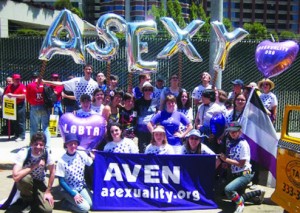Asexuals search for a place in gay culture
By Theresa Diffendal
The “A” in the acronym LGBTQIA+ that is used as an umbrella term for the queer community as a whole is thought by many to stand for allies. In fact, it represents a group with growing visibility: the asexual community.
Asexuality, defined as a lack of sexual attraction to other people, in conjunction with aromanticism, which a lack of romantic attraction to other people, exist on the aromantic/asexual, or aro/ace, spectrum.
The spectrum serves to show the degree to which people feel sexual or romantic attraction, with allosexual — those who experience sexual attraction on a regular basis, — at the opposite end of asexuality. Those who fall in between allo- and asexual on the spectrum often refer to themselves as “demi” or “gray” sexual or romantic.
However even as the queer community seeks to be all-inclusive and establish “safe spaces,” or places those with marginalized gender or sexual orientations can feel included, a rift has formed over the issue of hyper-sexuality.
Many queer-exclusive spaces have a reputation of being hyper-sexualized, such as Pride Parades, bathhouses, and gay bars. Many of these scenes also exclude members of the very community they are supposed to serve because they are only accessible to those over 21.
The increasing visibility of asexuality has many queer groups trying to find ways to adapt to accommodate those who do not engage in or are made uncomfortable by sexual activity.
The origination of the term asexuality as it refers to sexual orientation can be attributed to Michael Storms who, in 1979, put forth a model of sexuality similar to the aro/ace spectrum discussed above. The Kinsey Scale – a scale which rates sexual orientation from strictly heterosexual to strictly homosexual – also added the category “X” in its Kinsey Reports as early as 1948 to represent those who reported little to no sexual attraction.
Role of social media
Despite the early originations however, AVEN (the Asexual Visibility and Education Network) which focuses on issues related to asexuality, states that the first group for asexuals did not appear until October of 2000 in the form of a Yahoo group called “Haven for the Human Amoeba.”
Asexuality — and marginalized orientations in general — have often found acceptance and communities on the internet. Tumblr has a number of blogs whose purpose is to provide information about or help people come to terms with asexuality, such as asexual research.
Tri-Co Asexuality Group co-founder Gavriel Kleinwaks was quick to mention that the “advent of very liberal social media platforms like Tumblr” have helped to spread awareness of asexuality “because it’s just easier to find a community.”
But asexuality is not confined to that subsection of the internet. Studies of Britain and United Kingdom residents from 1994 to 2013 led by sexuality researcher Anthony Bogaert found between four tenths of a percent to 1.05% of the population reported a lack of sexual attraction to others.
AVEN was founded in 2001 by activist David Jay. It hosts a website dedicated to promoting asexuality through personal testimonies, video projects, and an annual Asexual Awareness Week in October.
Bryn Mawr College has emerged as a safe space for those who identify as a marginalized gender or sexual orientation. Along with the other two colleges in its consortium, Haverford and Swarthmore, asexuality has started to have a more visible presence on the campuses, namely the Tri-Co Asexuality Group at Haverford, an asexuality group at Swarthmore, and a recent aromanticism and asexuality panel at Bryn Mawr for LGBTQIA+ history month.
The panel consisted of nine current Bryn Mawr students who identify on the aro/ace spectrum. Connie, class of 2017, Sarah Moustafa, ‘16, and Kelsey Weymouth-Little, ‘16, all mentioned discovering the term asexuality through Tumblr posts. Maggie Alvarez, ’17, said she realized her sexuality when a friend defined the term “demisexual”, which means a romantic connection must be established before sexual attraction is felt.
Doing “physical stuff’
A few on the panel mentioned that their identity was a source of confusion or discomfort. Alvarez, who was in a relationship with an allosexual woman, said she was “scared she would dump me because I didn’t want to do physical stuff.” Weymouth-Little mentioned she “internalized a lot of negative stuff about my ace-ness.”
A portion of the panel was called “Shit Allo People Say,” which served to bring attention to harmful or negative phrases which were frequently directed to those on the aro-ace spectrum. Some examples: “Are you sexually attracted to objects?” “Maybe you just haven’t met the right person yet,” and “But, you’re attractive.”
These common feelings and confusion surrounding coming to terms with and coming out as asexual are some of the reasons Kleinwaks, Haverford ’18, helped form the Tri-Co Asexuality Group. In her experience, other queer exclusive spaces are not always safe spaces for those on the aro/ace spectrum. “I don’t feel like I’ve been in any exclusively queer spaces where I was not uncomfortable because of hyper sexuality…the ace group was kind of my effort to alleviate that,” she said
Weymouth-Little stressed that while she believes it is important for LGBT+ people to be able to express their sexuality in queer spaces because it is often “repressed in other places,” there is a tension. She added that queer spaces are not the only ones to blame, citing college campuses as “very hypersexualized places.”
Alvarez reflected on visibility and that while she noticed a lack of asexual representation at Philadelphia Pride she added, “New York’s pride fest had a mini-ace march…[and] I legitimately cried when I saw it.”
As asexuality and those who identify on the aro/ace spectrum continue to become more visible, the queer community will have to consider changing the atmosphere of its events if it wishes to remain an all-inclusive community.

